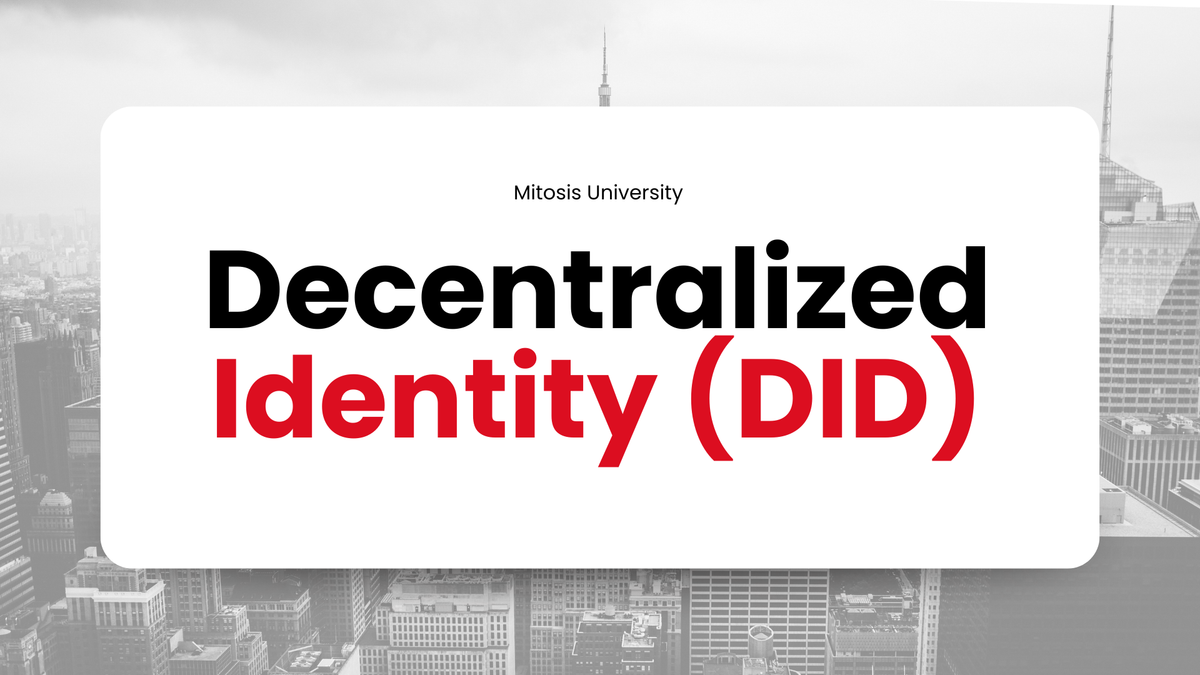Decentralized Identity (DID) - Frameworks, Privacy, and Real-World Use Cases

Introduction
In the digital age, managing identities securely and privately is crucial. Traditional centralized systems, where entities like governments or corporations control identity data, often expose users to risks like data breaches and privacy violations. Decentralized Identity (DID) offers a transformative solution, empowering individuals to own and control their digital identities.
Understanding Decentralized Identity (DID)
Decentralized Identity (DID) is a user-centric approach to digital identity management, where individuals create and manage their identities without relying on centralized authorities. At its core are Decentralized Identifiers (DIDs), unique, persistent identifiers stored on blockchain or distributed ledger technologies. These DIDs ensure immutability and security, allowing users to interact with services without exposing unnecessary personal data.
For example, a DID might look like "did:example:123456789abcdefghi", linking to a DID document containing public keys and service endpoints. This document enables the user to prove ownership and authenticate interactions, shifting control from service providers to individuals. Research from Dock Guide highlights that DIDs are independent of any organization, addressing issues like data ownership and breach risks in centralized systems.
Frameworks and Standards
The foundation of DID lies in standardized frameworks that ensure interoperability and trust. The World Wide Web Consortium (W3C) has developed the Decentralized Identifiers (DIDs) v1.0 specification W3C DID Core, published as a recommendation on July 19, 2022, and widely deployed as a standard for the Web. This specification defines:
- DID Structure: DIDs follow a URI scheme, starting with "did," followed by a method identifier and a unique identifier, ensuring global uniqueness.
- DID Documents: These are JSON or JSON-LD documents containing cryptographic material, verification methods, and service endpoints, serialized with media types like application/did+json or application/did+ld+json.
- Resolution Functions: Methods like resolve(did, resolutionOptions) retrieve DID documents, ensuring verifiability across systems.
The W3C specification includes 103 experimental DID method specifications and 32 driver implementations, with a test suite at W3C Test Suite. Other frameworks, such as Microsoft's Entra Verified ID Microsoft Entra, collaborate with organizations like the Decentralized Identity Foundation (DIF) to enhance DID adoption. These standards ensure that DIDs can be resolved and verified across compatible applications, fostering a cohesive ecosystem.
Privacy Aspects
DID significantly enhances privacy compared to traditional identity systems, where personal data is often siloed in centralized databases, vulnerable to breaches. Research suggests several privacy benefits:
- Selective Disclosure: Users can share only necessary information, such as proving they are over 18 without revealing their birth date, as noted in OneIdentity. This minimizes data exposure, aligning with data minimization principles in GDPR.
- Reduced Breach Risks: By decentralizing data storage, DID lowers the risk of large-scale data breaches. For instance, TechTarget explains that blockchain-based DIDs use public key infrastructure (PKI) for an immutable ledger, reducing vulnerabilities.
- User Control and Consent: Users can revoke access to their data at any time, ensuring they control who accesses their information. This user-centric approach, detailed in Identity.com Guide, enhances trust and compliance with privacy regulations.
Comparatively, centralized systems often force users to surrender privacy, as seen in frequent breaches at companies storing personal data, as discussed in Forbes Privacy. DID's design prioritizes privacy by design, making it a robust solution for protecting personal information.
Real-World Use Cases
DID is not merely theoretical; it is actively transforming industries with practical applications. Below is a table summarizing key use cases, their sectors, and benefits:
Sector | Use Case | Description | Benefits |
|---|---|---|---|
Financial Services | KYC Simplification | Users reuse verified KYC credentials across banks and fintechs. | Reduces onboarding delays, enhances privacy Dock Use Cases |
Healthcare | Secure Medical Record Sharing | Patients control access to medical records via DIDs. | Ensures data security, patient consent |
Education | Verifiable Credentials | Universities issue diplomas as DIDs for employer verification. | Speeds hiring, reduces fraud Identity.com Guide |
Government | Citizen Identity Management | Secure digital IDs for public services, reducing bureaucracy. | Enhances security, improves access Consensys |
Supply Chain | Product Authentication | DIDs track product authenticity from origin to consumer. | Ensures transparency, builds trust |
Travel | Seamless Identity Verification | Travelers present DIDs for airport checks without full identity exposure. | Streamlines processes, enhances privacy |
These use cases demonstrate DID's versatility. For instance, in finance, identity verification providers can issue KYC credentials, stored in digital wallets, and reused across services, as outlined in Dock Guide. In healthcare, patients can share specific medical data with providers, ensuring privacy and compliance, as seen in Kaleido Use Cases.
Challenges
Despite its benefits, DID faces challenges, including user adoption, technical complexity, and regulatory hurdles. Educating non-technical users about managing cryptographic keys is crucial, as noted in Built In, where losing private keys could result in permanent identity loss. Regulatory frameworks must also evolve to support DID, ensuring compliance with global standards.
The future of DID seems promising, with ongoing developments in standards and implementations. The W3C's active work, including 46 implementations submitted to the conformance test suite W3C DID Core, suggests growing adoption. Innovations like the European Digital Identity (EUDI) Wallet under eIDAS 2.0 Wikipedia DID indicate government interest, potentially driving widespread use.
Conclusion
Decentralized Identity (DID) represents a paradigm shift, offering users control, enhanced privacy, and secure interactions. Its standardized frameworks, like the W3C DID specification, ensure interoperability, while real-world use cases across finance, healthcare, and education highlight its practical value. As challenges are addressed, DID is poised to redefine digital identity management, fostering a more secure and user-centric digital future.
Key Citations
- W3C DID Core
- Microsoft Entra
- Dock Guide
- Forbes Privacy
- Kaleido Use Cases
- Identity.com Guide
- Consensys
- W3C Use Cases
- OneIdentity
- TechTarget
- Built In
- Wikipedia DID
MITOSIS official links:
GLOSSARY
Mitosis University
WEBSITE
X (Formerly Twitter)
DISCORD
DOCS



Comments ()